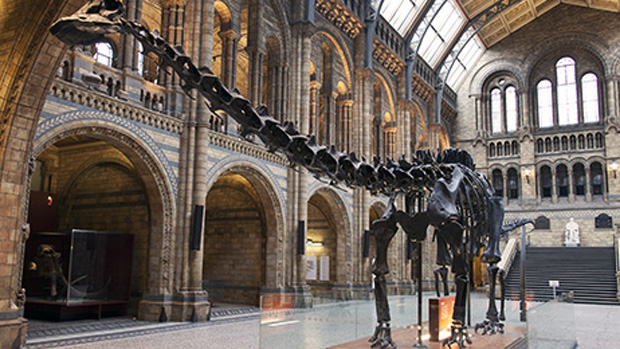Dippy: why is the Natural History Museum hiding its diplodocus?
#Savedippy campaign begins on Twitter as public outcry emerges over removal of diplodocus skeleton

News that the diplodocus skeleton which has graced the great hall of the Natural History Museum for three decades is to be replaced with a blue whale has been met with a wave of indignation and sadness on social media. So why has the museum decided to remove the iconic dinosaur?
What is the skeleton's origin?
The diplodocus skeleton that has stood in Hintze Hall for 35 years, affectionately known as "Dippy", is made up not of actual fossilised bones, but plaster casts from an original skeleton that was unearthed at the turn of the 20th century.
The Week
Escape your echo chamber. Get the facts behind the news, plus analysis from multiple perspectives.

Sign up for The Week's Free Newsletters
From our morning news briefing to a weekly Good News Newsletter, get the best of The Week delivered directly to your inbox.
From our morning news briefing to a weekly Good News Newsletter, get the best of The Week delivered directly to your inbox.
In about 1905, King Edward VII requested a copy of the original skeleton, housed in the Carnegie Museum in the US, after seeing a picture of it. Businessman Andrew Carnegie agreed and donated a complete replica, which went on display in the Natural History Museum's dinosaur hall. In 1979, Dippy took centre stage, and was placed in the Museum's main Hall.
Why is Dippy being removed?
The diplodocus is being removed to make way for the museum's blue whale skeleton. The museum believes that the whale skeleton will help in the presentation of its "three great narratives", the BBC reports.
These cover the evolution of life on earth, the diversity of life on the planet today, and the manner in which humans interact with the planet.
A free daily email with the biggest news stories of the day – and the best features from TheWeek.com
"Everyone loves 'Dippy', but it's just a copy," said Sir Michael Dixon, the Natural History Museum's director. "What makes this museum special is that we have real objects from the natural world – over 80 million of them – and they enable our scientists and thousands like them from around the world to do real research."
How has the public reacted to the news?
News of the skeleton's removal quickly drove "Dippy" to the top of Twitter trends. Hundreds of the social media network's users tweeted their sadness over the decision to remove the iconic dinosaur skeleton.
Dippy is retiring - I think I might cry! #savedippy — nicola randall (@nicrandall) January 29, 2015
I cannot believe they are moving #"Dippy" poor kids going in to the museum and not seeing him! It's just wrong! — josephine horman (@2013Horman) January 29, 2015
I've known about this for a while, but nooooo!! Don't get rid of Dippy!!! That dinosaur (cast of two) is iconic!!!http://t.co/kEO0wVXkbt — Jan Freedman (@JanFreedman) January 29, 2015
Ohh no! They want to replace Dippy with a blue whale skeleton at @NHM_London :( this upsets me more than it should've... — Flaumi (@flaumi) January 29, 2015
Several users suggested that the move was little more than a cheap PR stunt.
#dippygate - outrage / wisdom / v effective PR stunt? - http://t.co/4ghtwWFZvy — Ross Hawkins (@rosschawkins) January 29, 2015
Others attempted to understand the museum's decision.
Feeling torn between sentimentality and professional understanding http://t.co/TwJ7PDHq7c #dippy — Katherine Hebert (@K8Hebert) January 29, 2015
Some began using the hashtag #savedippy to try to get the decision reversed.
Sad to hear that Dippy the Diplodocus is leaving the Natural History Museum in 2017. He's the main reason I went there as a kid #savedippy — Rohan Seal (@Rohanseal221B) January 29, 2015
Genuinely upset at the @NHM_London plan to remove Dippy from the main hall. #SaveDippy — Dan H (@DapperDanHart) January 29, 2015
How did the museum respond?
Dixon acknowledged that some visitors disagreed with the move, but said that the change came as part of an important shift in the museum's emphasis.
"Although many people think of [the diplodocus] as a fixture in the main hall, for most of its time it has been in another gallery," he said. "It makes more sense to put him in a hall with other dinosaurs."
-
 7 bars with comforting cocktails and great hospitality
7 bars with comforting cocktails and great hospitalitythe week recommends Winter is a fine time for going out and drinking up
-
 7 recipes that meet you wherever you are during winter
7 recipes that meet you wherever you are during winterthe week recommends Low-key January and decadent holiday eating are all accounted for
-
 Nine best TV shows of the year
Nine best TV shows of the yearThe Week Recommends From Adolescence to Amandaland